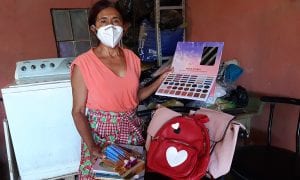The Last Mile: The Critical Role of Microfinance to Reach Those Hit Hardest by COVID-19
By Andrée Simon, President and CEO, FINCA Impact Finance
 The coronavirus pandemic has had a profound impact on the lives and livelihoods of people around the world, especially people in underserved and low-income communities. Poor households quickly adjusted to the economic disruption by curtailing their food consumption. Even as they resume their business activities, however, the future is clouded by economic uncertainty and lingering concerns about the virus.
The coronavirus pandemic has had a profound impact on the lives and livelihoods of people around the world, especially people in underserved and low-income communities. Poor households quickly adjusted to the economic disruption by curtailing their food consumption. Even as they resume their business activities, however, the future is clouded by economic uncertainty and lingering concerns about the virus.
Now more than ever, financial technology is crucial to keeping people connected to essential services, ensuring financial stability and sustaining incomes. Most people in the developing world depend on informal businesses to provide for themselves and their families. Because they cater to very basic needs, informal businesses are usually resilient in a crisis. But COVID has undermined their very foundation, disrupting supply chains, transportation and the flow of customers. Shut-off from mainstream banks, microfinance is a lifeline in these communities that helps stabilize cash flow and makes it possible to adapt to these challenges.
Why microfinance is a critical part of recovery
Microfinance services have the power to offer immediate support to small businesses impacted by unanticipated lockdowns and the resultant economic standstill, while also helping to provide sorely needed financial education and information for their customers. Microfinance also has a proven track record of reaching poor and historically excluded populations – providing critical last-mile distribution and services to communities that often don’t have access to mainstream financial services.
For example, Eugénie Kabeya, a FINCA Impact Finance customer since 2003, had been sewing women’s clothing from her small shop in Kinshasa, DRC for more than 17 years. In the first month of the pandemic, Eugénie lost 70% of her monthly revenue and had to let seven of her 12 employees go. With the encouragement of the FINCA staff at her local branch, she switched to producing masks – a product in high demand amid efforts to slow the spread of COVID-19.
Eugénie recalls, “One day I was talking with the manager at my local FINCA branch about the difficulties I was facing with my business and she reminded me: I am a tailor! I could easily put that to use to make masks and help my business by selling – turning COVID-19 from a strictly loss-making event to an opportunity.”
The power of knowing your customers
The key to serving customers like Eugénie is cultivating one-on-one, trusted relationships—and finding the right balance between high-tech delivery channels and an approach that fosters human connection. The microfinance sector, which collectively has reached more than 200 million people globally with credit, savings and other financial products to date, has spent decades elevating the voices of customers through widespread research efforts to better understand clients’ lives, needs and usage of financial services.
In FINCA’s case, we recently conducted more than 8,000 client interviews throughout the world to assess the impact of COVID-19. These conversations provided a range of important insights: Two-thirds of respondents in Uganda reported that their livelihoods were completely shut down as a result of COVID-19, while only a third of workers in Eurasia described their job losses as temporary. In some cases, we found important differences between urban and rural markets, and between different economic sectors. Such data enriches our understanding of what our customers are experiencing and shapes our response so that they can get back on their feet, while helping us set realistic expectations for the recovery phase.
The investment in branchless resources
When the impact of COVID-19 was first felt in vulnerable communities, the value of digital financial channels – such as agent networks, e-wallets and mobile banking – was immediately apparent. These technologies allow for continuity of service and spared customers the risk and inconvenience of travelling to branches. Investments in call centers, branchless channels, agents and mobile are all critical tools that protect the health of clients and staff.
Microfinance institutions have pioneered using digital tools in emerging markets, offering a new level of access and opportunity for individuals and small business owners. FINCA Impact Finance customers in the DRC for example use CLICK, a mobile app, to open an account, deposit and withdraw funds, conduct money transfers and receive payments from other users. CLICK can also be used to pay bills and check branch hours of operation – making it possible for customers to practice social distancing while banking.
Positive impact on people
Microfinance must continue to offer financial solutions, including loans that don’t overindebted borrowers, but which help them sustain their households while generating employment for the broader community. Client protection is more important than ever — FINCA Impact Finance enthusiastically supports the Client Protection Principles (overseen by The Social Performance Task Force (SPTF) and CERISE), because transparency and fairness are fundamental to our success.
A deep commitment to understanding and supporting our customers, putting their welfare at the forefront of every initiative, along with a presence in hard-to-reach areas, are what enable microfinance organizations like FIF to serve vulnerable individuals. Providing customers with the resources and flexibility to adapt to changing circumstances will ensure that they are not left behind as we emerge into a post-crisis world.